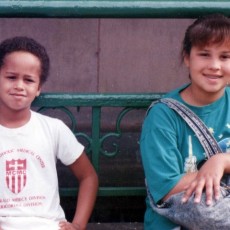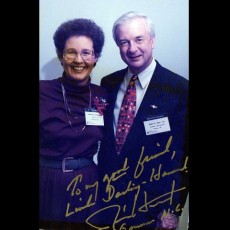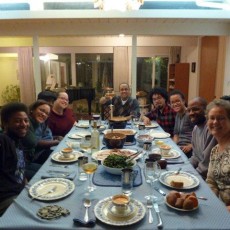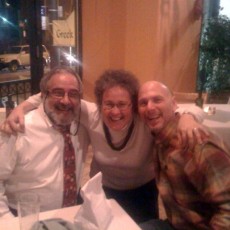Linda Darling-Hammond

Linda Darling-Hammond is Charles E. Ducommun Professor of Education at Stanford University and Co-Director of the Stanford Center for Opportunity Policy in Education. Having served as faculty sponsor for the Stanford Teacher Education Program, Dr. Darling-Hammond also launched the Stanford Educational Leadership Institute and the School Redesign Network. Both a member of the National Academy of Education and past president of the American Educational Research Association, Darling-Hammond’s research, teaching, and policy work focus on issues of school restructuring, teacher quality and educational equity. She was named one of the nation’s ten most influential people affecting education policy in the past decade. Awarded the 2010 Brock International Prize in Education for her contribution to the art and science of education, Dr. Darling-Hammond has authored more than 300 publications, most recently receiving the Grawemeyer Award (2012) for her book, The Flat World and Education.
For more information, visit Linda Darling-Hammond’s Website. To learn more about Linda Darling-Hammond from her family and friends, visit her Reflections. To view photographs from Linda Darling-Hammond’s personal collection, visit her Photo Gallery.
Curriculum Vitae Suggested readingsVisit the video below to watch a short overview of the interview with Linda Darling-Hammond. Otherwise, see all five of the full interviews with Linda Darling-Hammond below.
Video Interviews with Linda Darling-Hammond:
Born in Cleveland, Ohio-the city known as “the mistake on the lake” due to rampant pollution, Dr. Linda Darling-Hammond remembers the impact of federal policies such as new math and “innovative, interesting curriculum [reforms]” on her own education. Crediting her quality public education with stimulating her interest in the teaching profession, Darling-Hammond also observed the “very different educational experiences” of many other students. As the first woman in her family to go to college, Darling-Hammond was also among the first women to attend Yale University. A talented musician, she also developed a passion for teaching and teacher education while working to desegregate suburban schools. Concerned about the accessibility of knowledge for teachers and, subsequently, their students, Darling-Hammond envisioned the teaching profession as a combination of “ability, dedication, commitment, and talent” coupled with excellent preparation for the classroom. Watch this clip to hear Dr. Darling-Hammond’s beautiful rendition of Claude Debussy’s Arabesque No. 1 on the piano and learn more about her concern for the inequalities plaguing public schools then and now.
Admitting she was woefully “under-prepared for teaching,” Dr. Linda Darling-Hammond found the factory model high schools, uneven distribution of resources, and lack of adequate support for teachers frustrating. Darling-Hammond honed her research skills while attending Temple University on a scholarship before meeting her husband, Allen. Praised by her three children for her perseverance and devotion to her family, she worked to professionalize teaching while juggling the roles of wife, mother, and scholar. Described by her colleagues as a “dynamic educator,” Darling-Hammond characterizes herself first as a mother-always home for dinner and bedtime. In this clip of the show, find out more about Dr. Darling-Hammond’s role as an “institution builder” from those who know her best.
Described by a colleague as “a woman who can do everything and do it very well,” Dr. Linda Darling-Hammond worked to develop professional teaching standards, rejecting the old-fashion check list and multiple choice assessments. Instrumental as both an educator and scholar, Darling-Hammond and others founded a school before she joined academia first at Teachers College and later Stanford. As both a teacher and parent, she has “always wanted for other people’s children what she wanted for her own….” In this clip, learn more about Dr. Darling-Hammond’s assessment of the “teacher effect” in value-added measures.
Explaining the importance of both pedagogy and clinical experiences in a strong teacher preparation program, Dr. Linda Darling-Hammond collaborates with a variety of schools and districts while engaging in research and policy nationwide. Describing the “two different worlds” of policymakers and practitioners, she offers advice for legislators who seek to transform the public education system. Watch this clip to learn more about the most dangerous reforms for teachers in America today from Dr. Darling-Hammond.
Believing “you can’t stop working until the work is done…,” Dr. Linda Darling-Hammond’s support of quality public education is evident in the national requirement for highly qualified teachers. Characterizing teaching as a “work of art,” Darling-Hammond describes the complicated process of reform-comparing policy to sausage making! She also offers advice to graduate students, insisting they prepare academically and remain respectful of practitioners. In this clip, Dr. Darling-Hammond, known affectionately as “the tiger behind the smile,” shares her love for music and desire to make a difference.
Amrein-Beardsley, A. (2011, May 9). Inside the Academy video interviews with Dr. Linda Darling-Hammond [Video files]. Retrieved from /inside-the-academy/linda-darling-hammond

Dr. Barnett Berry
Describing Dr. Linda Darling-Hammond as “a gift to both her family and American public education,” Dr. Barnett Berry offers only praise for his mentor and friend. As she is “the most erudite scholar of teaching and learning in the United States,” Linda teaches “future teachers, administrators, policy analysts, and researchers,” preparing legions of educators to “do good for children and families.” An accomplished classical pianist, Linda touches lives as an extraordinary scholar, wife, and mother. Barnett notes that despite her commanding role as the “Michael Jordan of educational policy,” she maintains a “down to earth” sense of humility. Once addicted to a soap opera, Linda has been both a “powerful mentor [and] big sister” to her friend and colleague, Barnett. As she is one of the most accomplished scholars in her field, Linda wants “for other people’s children…what she wants for her [own] children.”

Dr. Prudence Carter
As co-director of the Stanford Center for Opportunity, Dr. Prudence Carter describes her colleague and friend, Dr. Linda Darling-Hammond, as “indefatigable” for her tireless work without complaint. “Balancing a wonderful career and lovely family,” Linda remains to those around her “a very warm soul.” Once intimidated by Linda, Prudence captures the essence and nature of her friend in simple but powerful terms: “brilliant, incredibly knowledgeable, kind-hearted, [and] humble-a change agent.” Known affectionately as a “Night Owl” for her willingness to respond to late night emails, Linda is also easily accessible by day to family, friends, and colleagues alike. “A gracious and gentle giant in the educational policy sphere,” Linda works to design and implement “a just and fair vision of our world.”

Elena Darling-Hammond
Characterizing her mother as “always there for [her], despite [a] busy schedule,” Elena Darling-Hammond is appreciative of her parent’s unwavering support. Also describing her mother as hardworking with a caring nature, Elena shares the belief that “truly well trained teachers can make a difference.” Once vehemently opposed to becoming a teacher herself, Elena admitted to sharing her mother’s commitment to education after taking her first college course on the subject. Dedicated to “helping people understand that teaching is a profession as important as that of doctors or lawyers,” her mother fosters this “reality every day through her work as a professor and policy maker.” A reputable “scrabble master” among family members, her mother has also been known to multitask-by conducting business or taking conference calls while exercising. Always ready to “put her work on hold for others to help or listen,” Linda has been “a key support” in the life of her daughter and many others.

Kia Darling-Hammond
Describing her mother as both “very supportive and wonderful,” Kia encapsulates her sentiment for her mother simply: “We get along exceptionally well…I love her.” Recalling her mother’s determination to dance with a broken foot at her daughter Elena’s wedding, Kia describes the fantastic scene, insisting “once the music started, it never stopped!” Proud of her mother for her perseverance, Kia credits her mother with bringing “equitable education to all children regardless of the era…and [doing so] with humility and grace.” Truly one of a kind, Linda “is driven by a love of people and commitment to bringing hope…for her family [and] friends, colleagues, and the world at large.”

Sean Darling-Hammond
Astonished by his mother’s ability to recall lengthy number sequences with little effort, Sean gave his mother the honorary title “Rain-Mom.” Linda and her son (called “Rain-Sean” for his own mental math skills) share “common quirks, humor, and a passion to improve the world.” An impactful researcher and scholar, she has demonstrated “the unquestionable importance of teacher preparedness and qualification on student performance.” Without her persistent advocacy, Sean notes that “there would be thousands, maybe even hundreds of thousands of kids who would be without the benefit of a qualified teacher….” Linda’s ability to both understand and communicate to policymakers “the educational realities facing today’s youth” is one of her greatest strengths in the eyes of her son. Recognizing her willingness to “put everything she has into improving our nation’s schools,” Sean easily captures his mother’s essence and nature in two words: “humbly brilliant.”

Dr. Carol D. Lee
Both Dr. Linda Darling-Hammond and her long-time friend, Dr. Carol D. Lee, took their practical experiences in the public school classroom with them to academia. Describing Linda as one of the “strongest women” she knows, Carol praises her colleague’s approach as “direct and forthright.” Leading the charge for small schools in New York City and increased professionalism, Linda is “at the center of the policy world in education.” Admired by Carol for her “tenacious fighting spirit,” Linda also maintains a strong family-she is a “loving wife and mother.” Held in the highest regard “on the Hill,” Linda has also captured the attention of key members of Congress, the Secretary of Education, and even the President of the United States. Insisting that “there’s a tiger behind that smile,” Carol respects Linda for her powerful ideas and profound understanding of education.

Dr. Rachel Lotan
Thrilled to work closely with Dr. Linda Darling-Hammond to redesign the Stanford Teacher Education Program, Dr. Rachel Lotan learned about “the nuts and bolts of teacher education….” Suspecting that her friend relies on sleep deprivation or a clone to maintain such high productivity, Rachel teases that “neither hypothesis has been disconfirmed yet!” Characterized by Rachel as “courageous,” Linda is a true “public intellectual” who interacts with “folks up and down the educational hierarchies.”

Dr. David Lyon
First meeting Dr. Linda Darling-Hammond at the RAND Corporation over 25 years ago, Dr. David Lyon is proud to have known the world renowned scholar “back when.” Both a talented researcher and fundraiser, Linda has “an ability to communicate that [is] rare in the world of academia”-she speaks clearly and to the point. David also notes that Linda is an accomplished pianist and a frequent guest at his “Live at the Living Room.” Playing and singing alongside fellow academics and other members of the community, she has shared beautiful renditions on the piano in the well-attended salon series. Respected by David for her consistent professionalism in a “world of uncertainty,” Linda is “first class in every way.”

Dr. Milbrey McLaughlin
Described as “a national presence,” Dr. Linda Darling-Hammond has known her friend and colleague, Dr. Milbrey McLaughlin for more than 30 years. First meeting Linda at the RAND Corporation, Milbrey notes that her friend is a “fierce advocate for teachers [and] an institution builder.” Milbrey also reveals that Linda has been a cabaret jazz singer! Described by Milbrey as “an optimist, a doer…[and] an outspoken crusader,” Linda is also a genuine artist.

Lonnie Moseley
Considering Dr. Linda Darling-Hammond her “exquisite gift from a Universe that loves” her, Lonnie Moseley first met her friend at Temple University in 1975. Having foreshadowed a marriage between Linda and her husband, Allen, within minutes of meeting him, Lonnie insists the name “Darling” fits her friend perfectly. After a nearly fatal illness, Lonnie recalls Linda’s response to her possible death-Linda stated simply: “That won’t be happening!” Having admonished the Grim Reaper, Linda also “maintained a trajectory of growing authority in her field” while raising three children who are as “fearless, competent, and compassionate” as she is. Willing to be “the ultimate adult in the room,” Linda manages to be “astonishingly brilliant…without her brightness making everyone else squint.”

Dr. Sharon Robinson
Standing “on principle even in the face of harsh and dishonest critique,” Dr. Linda Darling-Hammond “walks with kings” without losing the common touch. In addition to “sharing the passion, joys, and challenges of motherhood and public service” with her long-time friend, Dr. Sharon Robinson notes that “Linda [also] loves to have fun.” A competitive bid whist player, Linda embraces life “with amazing energy and very high standards of integrity.” Sharon explains that while Linda often consults with “eminent scholars and world leaders, she is devoted to her family and friends.” According to Sharon, Linda’s most significant accomplishment is her network of students. For these scholars, researchers, and practitioners, the “long, warm shadow of her example [will always] nurture and inspire their efforts.”

Dr. Lee Shulman
Dr. Lee Shulman sought to recruit his colleague and friend, Dr. Linda Darling-Hammond, to the Stanford University faculty long before she officially accepted a position. He notes that Linda is “fearless in her defense of serious teacher preparation…[even] attacking those initiatives that are most adored” by the media. Linda remains the “enemy of poor teaching.” In support of the same “professional preparation that [is taken] for granted in medicine, law, engineering, or architecture,” Linda is “capable of shifting her attention between the big policy questions…[and] specific challenges of practice.”

Dr. Joan Talbert
First working together to develop assessment protocols for the National Board for Professional Teaching Standards (NBPTS), Dr. Joan Talbert and Dr. Linda Darling-Hammond enjoyed evenings of “music and boogying…to celebrate the team spirit” after long days on the job. Joan describes “Linda [as] a community builder, creating commitment and a sense of belonging among those [with whom] she works.” Sharing a love of music, Linda and Joan have “enjoyed many potlucks, concerts, and sing-alongs [as part of] the ‘Live at the Living Room’ series.” She notes that Linda always “makes time to have fun with a wide circle of colleagues, friends, and family.”

Dr. Arthur Wise
Encountering the recent graduate, Dr. Linda Darling-Hammond, for the first time in 1978, Dr. Arthur Wise “knew that [he] was in the presence of an exceptional individual” by the end of the meeting. Since then, Arthur and Linda have “remained friends, collaborating on various initiatives to advance teaching as a profession.” Praising Linda as “an exemplary wife and mother,” Arthur fondly recalls a comical moment on an airplane with her then 4-year old daughter Kia who insisted that “a mother is the person who takes care of you when the babysitter cannot.” Balancing the challenges of modern motherhood with compassion and grace, Linda helped “re-conceptualize teaching” through her initial efforts at the RAND Corporation to the present. Linda’s primary goal will always be “to reform teaching and schools so that all learners are well-served.”


















































































